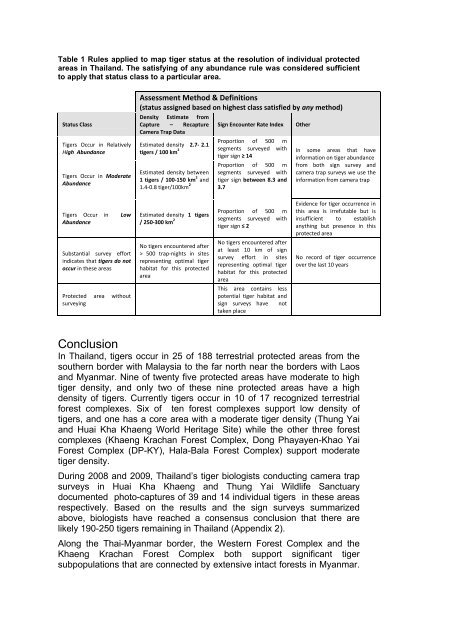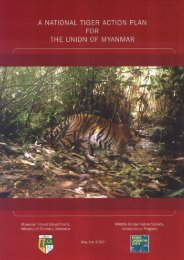Thailand Tiger Action Plan - Global Tiger Initiative
Thailand Tiger Action Plan - Global Tiger Initiative
Thailand Tiger Action Plan - Global Tiger Initiative
Create successful ePaper yourself
Turn your PDF publications into a flip-book with our unique Google optimized e-Paper software.
Table 1 Rules applied to map tiger status at the resolution of individual protectedareas in <strong>Thailand</strong>. The satisfying of any abundance rule was considered sufficientto apply that status class to a particular area.Status Class<strong>Tiger</strong>s Occur in RelativelyHigh Abundance<strong>Tiger</strong>s Occur in ModerateAbundanceAssessment Method & Definitions(status assigned based on highest class satisfied by any method)Density Estimate fromCapture – RecaptureCamera Trap DataSign Encounter Rate IndexProportion of 500 mEstimated density 2.7‐ 2.1tigers / 100 km 2 segments surveyed withtiger sign ≥ 14Proportion of 500 mEstimated density between segments surveyed with1 tigers / 100‐150 km 2 and tiger sign between 8.3 and1.4‐0.8 tiger/100km 2 3.7OtherIn some areas that haveinformation on tiger abundancefrom both sign survey andcamera trap surveys we use theinformation from camera trap<strong>Tiger</strong>s Occur in LowAbundanceSubstantial survey effortindicates that tigers do notoccur in these areasProtected area withoutsurveyingProportion of 500 mEstimated density 1 tigers/ 250‐300 km 2 segments surveyed withtiger sign ≤ 2No tigers encountered after> 500 trap‐nights in sitesrepresenting optimal tigerhabitat for this protectedareaNo tigers encountered afterat least 10 km of signsurvey effort in sitesrepresenting optimal tigerhabitat for this protectedareaThis area contains lesspotential tiger habitat andsign surveys have nottaken placeEvidence for tiger occurrence inthis area is irrefutable but isinsufficient to establishanything but presence in thisprotected areaNo record of tiger occurrenceover the last 10 yearsConclusionIn <strong>Thailand</strong>, tigers occur in 25 of 188 terrestrial protected areas from thesouthern border with Malaysia to the far north near the borders with Laosand Myanmar. Nine of twenty five protected areas have moderate to hightiger density, and only two of these nine protected areas have a highdensity of tigers. Currently tigers occur in 10 of 17 recognized terrestrialforest complexes. Six of ten forest complexes support low density oftigers, and one has a core area with a moderate tiger density (Thung Yaiand Huai Kha Khaeng World Heritage Site) while the other three forestcomplexes (Khaeng Krachan Forest Complex, Dong Phayayen-Khao YaiForest Complex (DP-KY), Hala-Bala Forest Complex) support moderatetiger density.During 2008 and 2009, <strong>Thailand</strong>’s tiger biologists conducting camera trapsurveys in Huai Kha Khaeng and Thung Yai Wildlife Sanctuarydocumented photo-captures of 39 and 14 individual tigers in these areasrespectively. Based on the results and the sign surveys summarizedabove, biologists have reached a consensus conclusion that there arelikely 190-250 tigers remaining in <strong>Thailand</strong> (Appendix 2).Along the Thai-Myanmar border, the Western Forest Complex and theKhaeng Krachan Forest Complex both support significant tigersubpopulations that are connected by extensive intact forests in Myanmar.
















